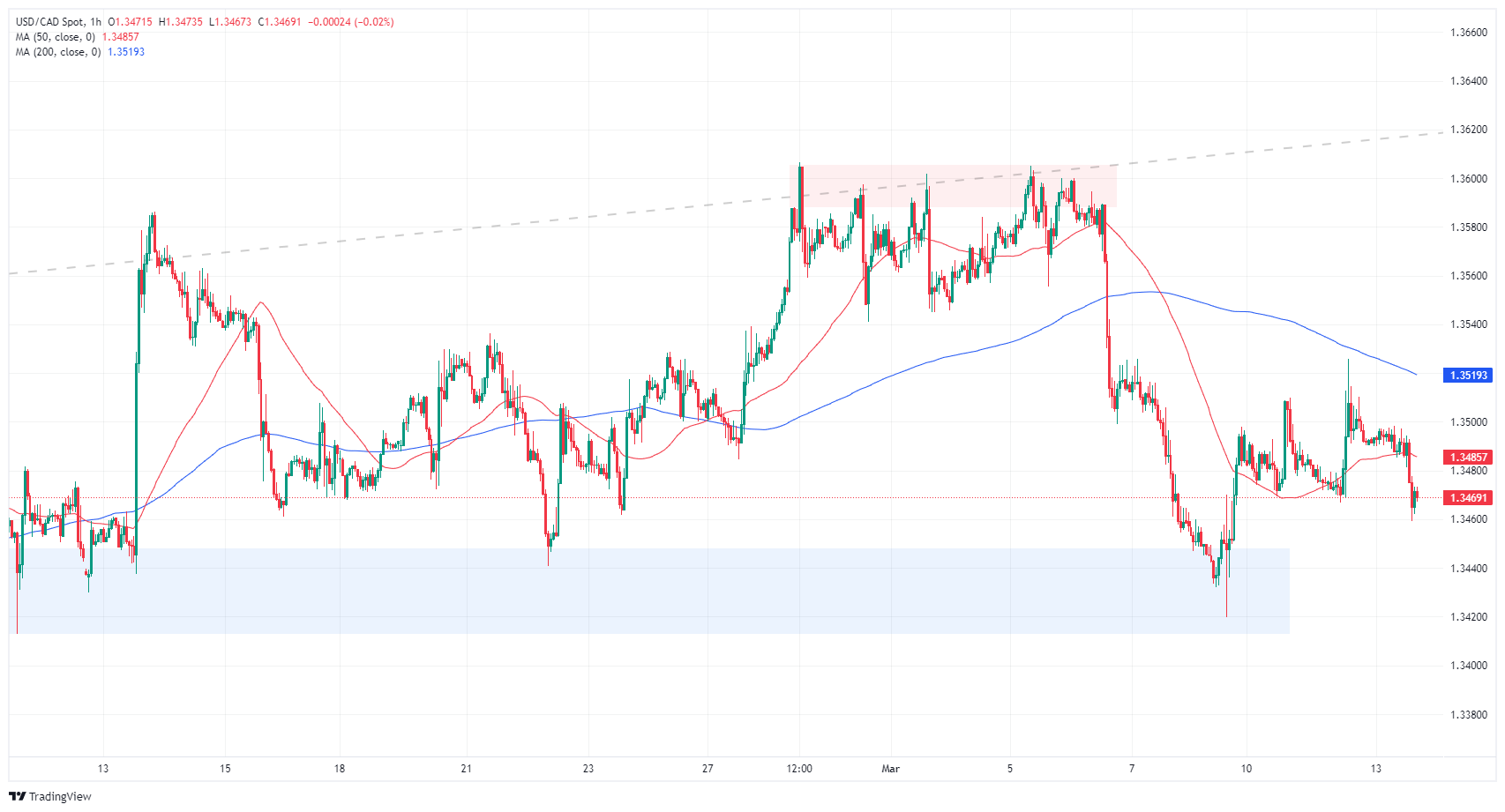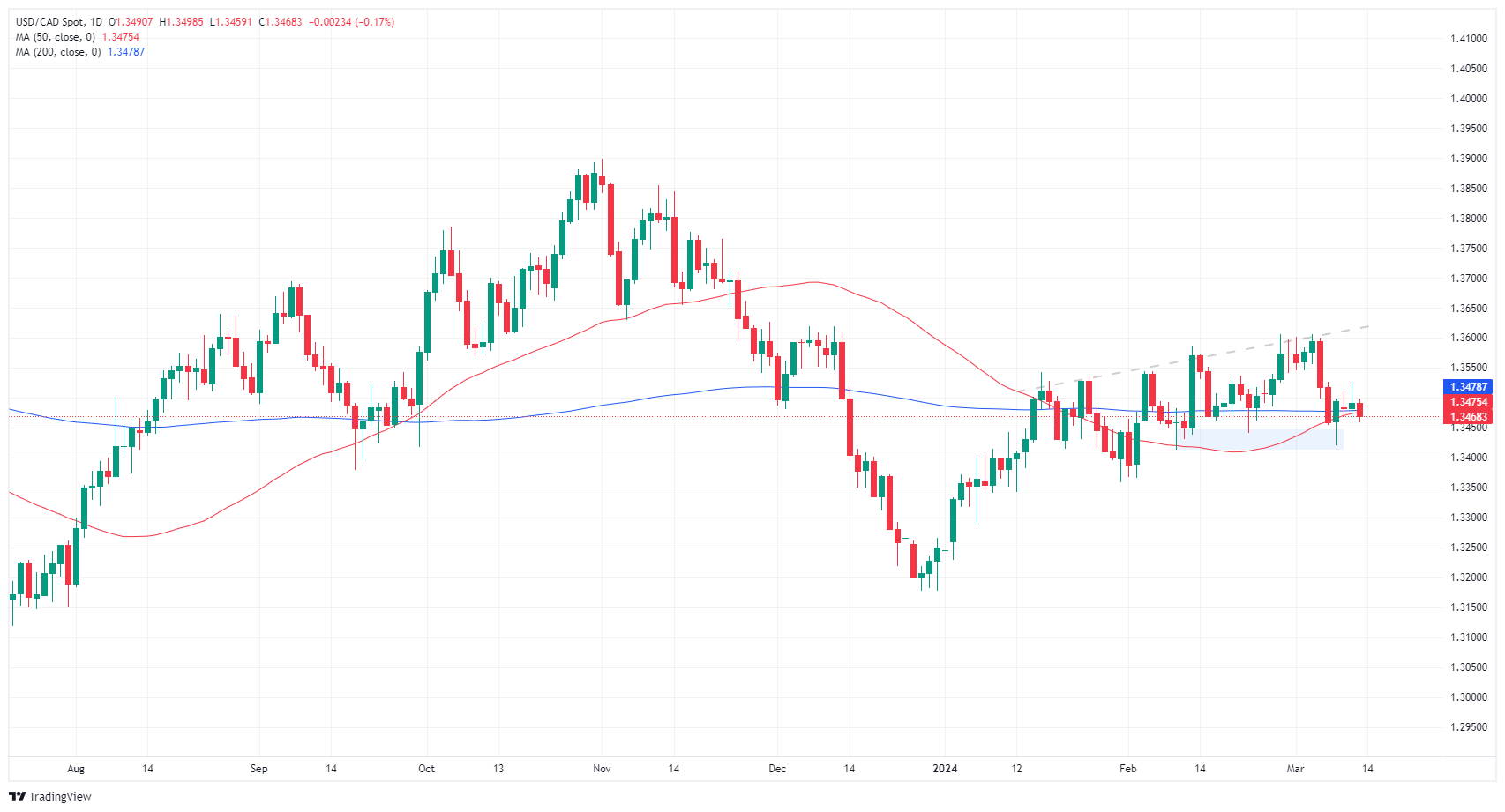- Canadian Dollar pulls back to even against US Dollar midweek.
- Canada brings little data of note to the table.
- US PPE, Retail Sales on offer for Thursday.
The Canadian Dollar (CAD) found some room on the upside at the midweek inflection point as investors await Thursday’s US Producer Price Index (PPI) and Retail Sales figures. The CAD continues to wrestle with the US Dollar (USD), but the Canadian Dollar is on pace to be one of the strongest performers this week as the only major currency entirely in the green.
Go figure! Canada’s high-performance week comes when there’s no meaningful Canadian data on offer. Canadian Manufacturing Sales for January, slated for Thursday, are expected to recover to 0.4% from the previous -0.7%. Canadian Housing Starts come on Friday, expected to tick up slightly to 230K from 223.6K. Neither print is expected to draw much attention, if any.
After Thursday’s US PPE and Retail Sales, Friday will wrap things up with another round of University of Michigan Consumer Sentiment and Expectation prints for March. UoM Consumer Sentiment is forecast to hold steady at 76.9, while UoM Consumer Inflation Expectations last showed US consumers expected annual inflation to land somewhere around 2.9%.
Canadian Dollar price this week
The table below shows the percentage change of Canadian Dollar (CAD) against listed major currencies this week. Canadian Dollar was the strongest against the Japanese Yen.
| USD | EUR | GBP | CAD | AUD | JPY | NZD | CHF | |
| USD | -0.14% | 0.40% | -0.16% | -0.10% | 0.54% | 0.24% | -0.06% | |
| EUR | 0.13% | 0.53% | -0.04% | 0.03% | 0.68% | 0.37% | 0.08% | |
| GBP | -0.39% | -0.52% | -0.56% | -0.49% | 0.16% | -0.14% | -0.44% | |
| CAD | 0.17% | 0.03% | 0.56% | 0.06% | 0.67% | 0.40% | 0.10% | |
| AUD | 0.09% | -0.04% | 0.49% | -0.07% | 0.64% | 0.33% | 0.04% | |
| JPY | -0.53% | -0.68% | 0.09% | -0.72% | -0.64% | -0.30% | -0.61% | |
| NZD | -0.24% | -0.38% | 0.16% | -0.41% | -0.34% | 0.30% | -0.30% | |
| CHF | 0.04% | -0.07% | 0.44% | -0.10% | -0.05% | 0.59% | 0.28% |
The heat map shows percentage changes of major currencies against each other. The base currency is picked from the left column, while the quote currency is picked from the top row. For example, if you pick the Euro from the left column and move along the horizontal line to the Japanese Yen, the percentage change displayed in the box will represent EUR (base)/JPY (quote).
Technical analysis: USD/CAD stuck into week’s lows as Canadian Dollar fights back
The Canadian Dollar (CAD) started Wednesday on the front foot, finding gains against the majority of its major currency peers before slightly softening during the American trading session. At the time of writing, the CAD is down around a sixth of a percent against the Australian Dollar (AUD) and tipping into the red against the Euro (EUR) but still within a tenth of a percent of the day's opening bids. The CAD is up around a fifth of a percent against the US Dollar and has gained around a sixth of a percent against both the Swiss Franc (CHF) and the Japanese Yen (JPY).
USD/CAD slipped back into the week’s low bids as the Canadian Dollar found firmer footing, setting a new low for the week near 1.3460. The pair is still on the high side of last week’s swoon into 1.3420, and near-term price action has a technical ceiling priced in at the 200-hour Simple Moving Average (SMA) near 1.3520.
Daily candles continue to get hung up on the pair’s 200-day SMA at 1.3478, and directional momentum remains limited despite a recent pattern of higher highs. A supply zone is priced in just above the 1.3400 handle.
USD/CAD hourly chart
USD/CAD daily chart
Canadian Dollar FAQs
The key factors driving the Canadian Dollar (CAD) are the level of interest rates set by the Bank of Canada (BoC), the price of Oil, Canada’s largest export, the health of its economy, inflation and the Trade Balance, which is the difference between the value of Canada’s exports versus its imports. Other factors include market sentiment – whether investors are taking on more risky assets (risk-on) or seeking safe-havens (risk-off) – with risk-on being CAD-positive. As its largest trading partner, the health of the US economy is also a key factor influencing the Canadian Dollar.
The Bank of Canada (BoC) has a significant influence on the Canadian Dollar by setting the level of interest rates that banks can lend to one another. This influences the level of interest rates for everyone. The main goal of the BoC is to maintain inflation at 1-3% by adjusting interest rates up or down. Relatively higher interest rates tend to be positive for the CAD. The Bank of Canada can also use quantitative easing and tightening to influence credit conditions, with the former CAD-negative and the latter CAD-positive.
The price of Oil is a key factor impacting the value of the Canadian Dollar. Petroleum is Canada’s biggest export, so Oil price tends to have an immediate impact on the CAD value. Generally, if Oil price rises CAD also goes up, as aggregate demand for the currency increases. The opposite is the case if the price of Oil falls. Higher Oil prices also tend to result in a greater likelihood of a positive Trade Balance, which is also supportive of the CAD.
While inflation had always traditionally been thought of as a negative factor for a currency since it lowers the value of money, the opposite has actually been the case in modern times with the relaxation of cross-border capital controls. Higher inflation tends to lead central banks to put up interest rates which attracts more capital inflows from global investors seeking a lucrative place to keep their money. This increases demand for the local currency, which in Canada’s case is the Canadian Dollar.
Macroeconomic data releases gauge the health of the economy and can have an impact on the Canadian Dollar. Indicators such as GDP, Manufacturing and Services PMIs, employment, and consumer sentiment surveys can all influence the direction of the CAD. A strong economy is good for the Canadian Dollar. Not only does it attract more foreign investment but it may encourage the Bank of Canada to put up interest rates, leading to a stronger currency. If economic data is weak, however, the CAD is likely to fall.
Information on these pages contains forward-looking statements that involve risks and uncertainties. Markets and instruments profiled on this page are for informational purposes only and should not in any way come across as a recommendation to buy or sell in these assets. You should do your own thorough research before making any investment decisions. FXStreet does not in any way guarantee that this information is free from mistakes, errors, or material misstatements. It also does not guarantee that this information is of a timely nature. Investing in Open Markets involves a great deal of risk, including the loss of all or a portion of your investment, as well as emotional distress. All risks, losses and costs associated with investing, including total loss of principal, are your responsibility. The views and opinions expressed in this article are those of the authors and do not necessarily reflect the official policy or position of FXStreet nor its advertisers. The author will not be held responsible for information that is found at the end of links posted on this page.
If not otherwise explicitly mentioned in the body of the article, at the time of writing, the author has no position in any stock mentioned in this article and no business relationship with any company mentioned. The author has not received compensation for writing this article, other than from FXStreet.
FXStreet and the author do not provide personalized recommendations. The author makes no representations as to the accuracy, completeness, or suitability of this information. FXStreet and the author will not be liable for any errors, omissions or any losses, injuries or damages arising from this information and its display or use. Errors and omissions excepted.
The author and FXStreet are not registered investment advisors and nothing in this article is intended to be investment advice.
Recommended content
Editors’ Picks
EUR/USD stays in positive territory above 1.0850 after US data

EUR/USD clings to modest daily gains above 1.0850 in the second half of the day on Friday. The improving risk mood makes it difficult for the US Dollar to hold its ground after PCE inflation data, helping the pair edge higher ahead of the weekend.
GBP/USD stabilizes above 1.2850 as risk mood improves

GBP/USD maintains recovery momentum and fluctuates above 1.2850 in the American session on Friday. The positive shift seen in risk mood doesn't allow the US Dollar to preserve its strength and supports the pair.
Gold rebounds above $2,380 as US yields stretch lower

Following a quiet European session, Gold gathers bullish momentum and trades decisively higher on the day above $2,380. The benchmark 10-year US Treasury bond yield loses more than 1% on the day after US PCE inflation data, fuelling XAU/USD's upside.
Avalanche price sets for a rally following retest of key support level

Avalanche (AVAX) price bounced off the $26.34 support level to trade at $27.95 as of Friday. Growing on-chain development activity indicates a potential bullish move in the coming days.
The election, Trump's Dollar policy, and the future of the Yen

After an assassination attempt on former President Donald Trump and drop out of President Biden, Kamala Harris has been endorsed as the Democratic candidate to compete against Trump in the upcoming November US presidential election.